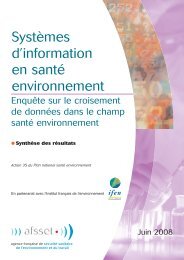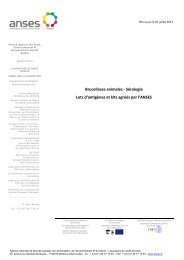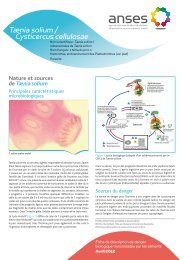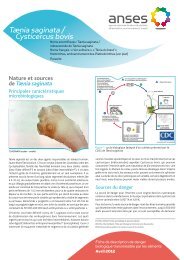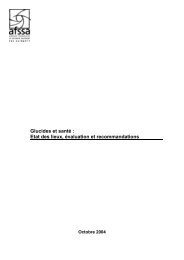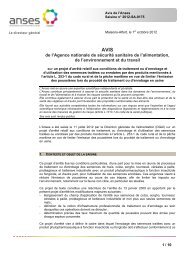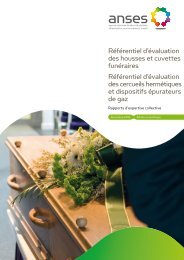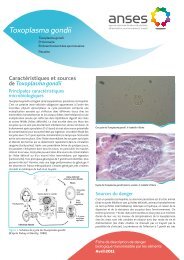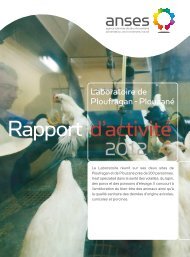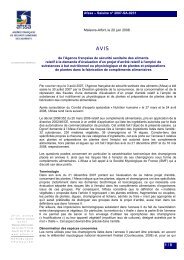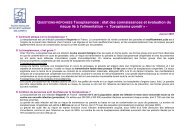Anisakisspp., Pseudoterranovaspp. - Anses
Anisakisspp., Pseudoterranovaspp. - Anses
Anisakisspp., Pseudoterranovaspp. - Anses
Create successful ePaper yourself
Turn your PDF publications into a flip-book with our unique Google optimized e-Paper software.
The probability of Anisakidae infesting farmed fish (salmon in particular),<br />
when their diet is controlled, is considered as zero to near-zero.<br />
Lesions and diseases in fish vary depending on the intensity of the<br />
infestation and on the species (host and parasite). The main manifestations<br />
are overloading of the abdominal cavity, localised mechanical compression<br />
of tissues and the formation of granulomas around the parasite (sometimes<br />
causing its death). Anisakis larvae are mainly located in the abdominal<br />
cavity, whereas those of Pseudoterranova tend to be found in muscles.<br />
Transmission routes<br />
Transmission to humans is almost exclusively via food. Consumption of<br />
raw or undercooked fish is responsible for infestation. Some rare cases of<br />
non-food allergies, from direct contact with infected animals, have also<br />
been observed.<br />
Recommendations for primary production<br />
• All wild marine fish species should be considered as<br />
potentially contaminated, since due to a lack of information,<br />
no geographical area is known to be free of parasites.<br />
• In marine and inland aquaculture, diet should be controlled<br />
(only use feed made from compound feedingstuffs)<br />
throughout the life cycle, beginning from the egg stage, to<br />
maintain a near-zero risk of infestation.<br />
Human foodborne illness<br />
Nature of the disease<br />
The clinical symptoms induced by different Anisakidae genera are broadly<br />
similar. The Table 1 below includes all the symptoms, but they may appear<br />
differently depending on the patient and location of the parasite.<br />
Susceptible population groups (1) : people with an inherited predisposition,<br />
in whom the repeated ingestion of Anisakidae larvae, including dead ones,<br />
can cause allergy and may even result in anaphylactic shock. Conversely,<br />
sensitisation of “naive” subjects to Anisakidae allergens only results in the<br />
presence of specific IgE antibodies. It is likely that sensitivity to Anisakis<br />
allergens is initiated by infection with a live larva. However, once this<br />
sensitivity has been acquired, allergic episodes may be triggered by a live<br />
larva or by the allergens alone (from dead larvae).<br />
Dose-effect (2) relationships<br />
The presence of one larva is sufficient to cause the syndromes described<br />
in the Table 1.<br />
Epidemiology<br />
There are over 2500 cases of anisakiasis per year in Japan, the most affected<br />
industrialised country. In the United States, the incidence is 10 cases per<br />
year. In Europe, the countries where anisakiasis is most commonly reported<br />
are Spain, Norway, the Netherlands and the United Kingdom. The exact<br />
incidence is difficult to establish, but seems to average fewer than 20<br />
cases per country per year. However in 2005, a total of over 30 cases was<br />
reported in Italy. In France, a report by the InVS in 2003 estimated the<br />
incidence at eight cases per year, using data from a study conducted in<br />
1985-1987.<br />
The phenomena of allergic anisakiasis and sensitisation to Anisakis<br />
allergens have been a growing concern since they were first described<br />
in the 1990s. Indeed, a prevalence of around 12.4% of patients with IgE<br />
antibodies specific to A. simplex has been observed in the Madrid area.<br />
A Spanish study has implicated Anisakis in 10% of anaphylactic shocks<br />
resulting from allergic reactions. Moreover, Anisakis is responsible for the<br />
majority of allergic reactions due to hidden allergens (allergens to date<br />
unidentified as major allergens by the regulations stipulating labelling<br />
provisions, or not declared on the product label).<br />
Role of food<br />
Main foods to consider<br />
Humans become infected by eating contaminated fish or cephalopods<br />
that are raw, undercooked or preserved in preparations low in salt or acetic<br />
acid. In infested fish, it has been shown that the number of larvae generally<br />
increases with age, and therefore in proportion to the size of the fish.<br />
In France, various surveys (1988, 1993, 1994) on infestation rates in<br />
the most frequently consumed commercial fish species have led to the<br />
discovery of infestation rates of around 80% for anchovies, 30% for<br />
mackerel, 70% for whiting, 90% for hake and 60% for horse mackerel.<br />
The various culinary preparations that may lead to contamination<br />
include sushi (raw fish), bottarga (made from dried or smoked fish eggs),<br />
rollmops (herrings marinated in white wine or vinegar), kippers (smoked<br />
fish), Tahitian fish or “ceviche” (fish marinated in lemon) and marinated<br />
anchovies.<br />
(1) Susceptible population group: people with a higher than average probability of developing<br />
symptoms of the disease, or severe forms of the disease, after exposure to a foodborne hazard<br />
[definition used for the ANSES data sheets].<br />
(2) The relationship between the dose (the amount of microbial cells ingested during a meal)<br />
and the effect on an individual<br />
Table 1. Disease characteristics<br />
Mean incubation<br />
period<br />
Main symptoms<br />
Duration<br />
of symptoms<br />
Duration<br />
of infectious<br />
period<br />
(shedding)<br />
Complications<br />
Asymptomatic<br />
forms<br />
From 1 to 12 hours<br />
Gastric (abdominal pain, nausea, vomiting<br />
and/or diarrhoea, pseudo-ulcerous manifestations)<br />
and/or*<br />
Several days to several<br />
weeks in chronic cases<br />
Not applicable<br />
Bowel obstruction<br />
Yes,<br />
No data available on<br />
proportions<br />
From 12 h to more<br />
than 5 days<br />
Intestinal (nausea, vomiting and/or diarrhoea,<br />
appendicular or peritoneal syndromes, rare colitis<br />
or ileitis forms )<br />
Several days to several<br />
weeks in chronic cases<br />
Not applicable<br />
Bowel obstruction<br />
Yes,<br />
No data available on<br />
proportions<br />
From a few hours<br />
to 24 h<br />
• Gastro-allergic anisakiasis (e.g. digestive allergies,<br />
hives) caused by live larvae<br />
• Skin allergies (hives (20%), angioedema)<br />
caused by live or dead larvae.<br />
1 day Not applicable<br />
20 to 60% of cases are<br />
severe (angioedema,<br />
anaphylactic shock<br />
which can be fatal).<br />
Yes,<br />
No data available on<br />
proportions<br />
* The symptoms are related to penetration by the larvae of the gastric and/or intestinal mucosa.<br />
2 Data sheet on foodborne biological hazards / Anisakis spp., Pseudoterranova spp.





